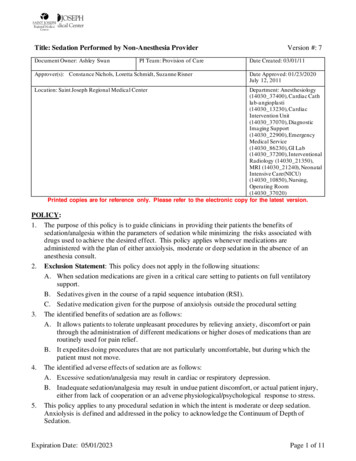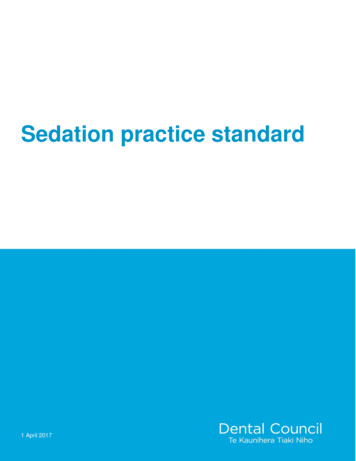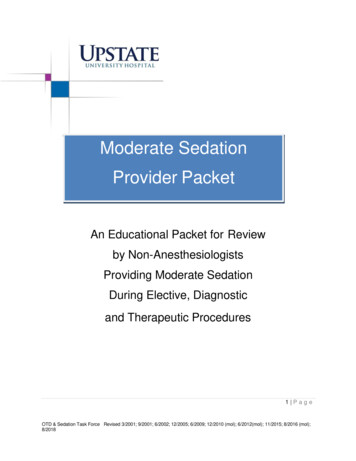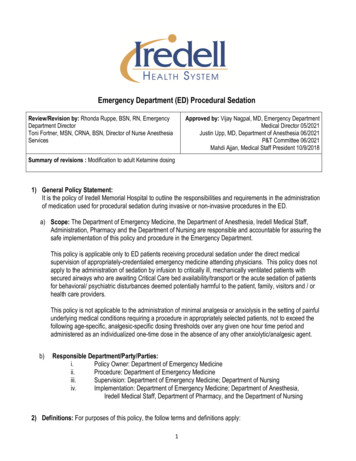
Transcription
䡵 SPECIAL ARTICLEAnesthesiology 2002; 96:1004 –17 2002 American Society of Anesthesiologists, Inc. Lippincott Williams & Wilkins, Inc.Practice Guidelines for Sedation and Analgesia byNon-AnesthesiologistsAn Updated Report by the American Society of Anesthesiologists Task Force onSedation and Analgesia by Non-AnesthesiologistsANESTHESIOLOGISTS possess specific expertise in thepharmacology, physiology, and clinical management of patients receiving sedation and analgesia. For this reason, theyare frequently called on to participate in the developmentof institutional policies and procedures for sedation andanalgesia for diagnostic and therapeutic procedures. Toassist in this process, the American Society of Anesthesiologists (ASA) has developed these “Guidelines for Sedationand Analgesia by Non-Anesthesiologists.”Practice guidelines are systematically developed recommendations that assist the practitioner and patient inmaking decisions about health care. These recommendations may be adopted, modified, or rejected accordingto clinical needs and constraints. Practice guidelines arenot intended as standards or absolute requirements. Theuse of practice guidelines cannot guarantee any specificoutcome. Practice guidelines are subject to revision aswarranted by the evolution of medical knowledge, technology, and practice. The guidelines provide basic recommendations that are supported by analysis of thecurrent literature and by a synthesis of expert opinion,open forum commentary, and clinical feasibility data.This revision includes data published since the “Guidelines for Sedation and Analgesia by Non-Anesthesiologists” were adopted by the ASA in 1995; it also includes Additional material related to this article can be found on theANESTHESIOLOGY Web site. Go to the following address, click onEnhancements Index, and then scroll down to find the appropriate article and link. http://www.anesthesiology.orgDeveloped by the American Society of Anesthesiologists Task Force on Sedation and Analgesia by Non-Anesthesiologists: Jeffrey B. Gross, M.D. (Chair),Farmington, CT; Peter L. Bailey, M.D., Rochester, NY; Richard T. Connis, Ph.D.,Woodinville, WA; Charles J. Coté, M.D., Chicago, IL; Fred G. Davis, M.D.,Burlington, MA; Burton S. Epstein, M.D., Washington, DC; Lesley Gilbertson,M.D., Boston, MA; David G. Nickinovich, Ph.D., Bellevue, WA; John M. Zerwas,M.D., Houston, TX; Gregory Zuccaro, Jr., M.D., Cleveland, OH.Submitted for publication November 30, 2001. Accepted for publicationNovember 30, 2001. Supported by the American Society of Anesthesiologistsunder the direction of James F. Arens, M.D., Chairman, Committee on PracticeParameters. Approved by the House of Delegates, October 17, 2001. A list of thereferences used to develop these Guidelines is available by writing to theAmerican Society of Anesthesiologists. These Guidelines have been endorsed byThe American College of Radiology, The American Association of Oral andMaxillofacial Surgeons, and The American Society for GastrointestinalEndoscopy.The accompanying Web site enhacement is a bibliography.Address reprint requests to American Society of Anesthesiologists: 520 N.Northwest Highway, Park Ridge, Illinois 60068-2573.Anesthesiology, V 96, No 4, Apr 2002data and recommendations for a wider range of sedationlevels than was previously addressed.Definitions“Sedation and analgesia” comprise a continuum ofstates ranging from minimal sedation (anxiolysis)through general anesthesia. Definitions of levels of sedation–analgesia, as developed and adopted by the ASA,are given in table 1. These Guidelines specifically applyto levels of sedation corresponding to moderate sedation(frequently called conscious sedation) and deep sedation, as defined in table 1.FocusThese Guidelines are designed to be applicable toprocedures performed in a variety of settings (e.g., hospitals, freestanding clinics, physician, dental, and otheroffices) by practitioners who are not specialists in anesthesiology. Because minimal sedation (anxiolysis) entailsminimal risk, the Guidelines specifically exclude it. Examples of minimal sedation include peripheral nerveblocks, local or topical anesthesia, and either (1) lessthan 50% nitrous oxide (N2O) in oxygen with no othersedative or analgesic medications by any route, or (2) asingle, oral sedative or analgesic medication administered in doses appropriate for the unsupervised treatment of insomnia, anxiety, or pain. The Guidelines alsoexclude patients who are not undergoing a diagnostic ortherapeutic procedure (e.g., postoperative analgesia, sedation for treatment of insomnia). Finally, the Guidelinesdo not apply to patients receiving general or majorconduction anesthesia (e.g., spinal or epidural/caudalblock), whose care should be provided, medically directed, or supervised by an anesthesiologist, the operating practitioner, or another licensed physician with specific training in sedation, anesthesia, and rescuetechniques appropriate to the type of sedation or anesthesia being provided.PurposeThe purpose of these Guidelines is to allow cliniciansto provide their patients with the benefits of sedation/analgesia while minimizing the associated risks. Se-1004
PRACTICE GUIDELINES1005Table 1. Continuum of Depth of Sedation: Definition of General Anesthesia and Levels of Sedation/AnalgesiaMinimal scious Sedation)Deep Sedation/AnalgesiaGeneral AnesthesiaPurposeful* response afterrepeated or painfulstimulationIntervention may be requiredUnarousable, evenwith painful stimulusMay be inadequateUsually maintainedResponsivenessNormal response toverbal stimulationAirwayUnaffectedPurposeful* response toverbal or tactilestimulationNo intervention requiredSpontaneous ventilationCardiovascular functionUnaffectedUnaffectedAdequateUsually maintainedIntervention oftenrequiredFrequently inadequateMay be impairedMinimal Sedation (Anxiolysis) a drug-induced state during which patients respond normally to verbal commands. Although cognitive function and coordinationmay be impaired, ventilatory and cardiovascular functions are unaffected.Moderate Sedation/Analgesia (Conscious Sedation) a drug-induced depression of consciousness during which patients respond purposefully* to verbalcommands, either alone or accompanied by light tactile stimulation. No interventions are required to maintain a patent airway, and spontaneous ventilation isadequate. Cardiovascular function is usually maintained.Deep Sedation/Analgesia a drug-induced depression of consciousness during which patients cannot be easily aroused but respond purposefully* followingrepeated or painful stimulation. The ability to independently maintain ventilatory function may be impaired. Patients may require assistance in maintaining a patentairway, and spontaneous ventilation may be inadequate. Cardiovascular function is usually maintained.General Anesthesia a drug-induced loss of consciousness during which patients are not arousable, even by painful stimulation. The ability to independentlymaintain ventilatory function is often impaired. Patients often require assistance in maintaining a patent airway, and positive pressure ventilation may be requiredbecause of depressed spontaneous ventilation or drug-induced depression of neuromuscular function. Cardiovascular function may be impaired.Because sedation is a continuum, it is not always possible to predict how an individual patient will respond. Hence, practitioners intending to produce a givenlevel of sedation should be able to rescue patients whose level of sedation becomes deeper than initially intended. Individuals administering ModerateSedation/Analgesia (Conscious Sedation) should be able to rescue patients who enter a state of Deep Sedation/Analgesia, while those administering DeepSedation/Analgesia should be able to rescue patients who enter a state of general anesthesia.* Reflex withdrawal from a painful stimulus is not considered a purposeful response.Developed by the American Society of Anesthesiologists; approved by the ASA House of Delegates October 13, 1999.dation/analgesia provides two general types of benefit:(1) sedation/analgesia allows patients to tolerate unpleasant procedures by relieving anxiety, discomfort, orpain; and (2) in children and uncooperative adults, sedation–analgesia may expedite the conduct of procedures that are not particularly uncomfortable but thatrequire that the patient not move. At times, these sedationpractices may result in cardiac or respiratory depression,which must be rapidly recognized and appropriatelymanaged to avoid the risk of hypoxic brain damage, cardiac arrest, or death. Conversely, inadequate sedation–analgesia may result in undue patient discomfort or patientinjury because of lack of cooperation or adverse physiologic or psychological response to stress.mised airway or hypoventilation in a patient who responds purposefully after repeated or painful stimulation, whereas for deep sedation, this implies the abilityto manage respiratory or cardiovascular instability in apatient who does not respond purposefully to painful orrepeated stimulation. Levels of sedation referred to inthe recommendations relate to the level of sedationintended by the practitioner. Examples are provided toillustrate airway assessment, preoperative fasting, emergency equipment, and recovery procedures; however,clinicians and their institutions have ultimate responsibility for selecting patients, procedures, medications,and equipment.Task Force Members and ConsultantsApplicationThese Guidelines are intended to be general in theirapplication and broad in scope. The appropriate choiceof agents and techniques for sedation/analgesia is dependent on the experience and preference of the individualpractitioner, requirements or constraints imposed by thepatient or procedure, and the likelihood of producing adeeper level of sedation than anticipated. Because it isnot always possible to predict how a specific patient willrespond to sedative and analgesic medications, practitioners intending to produce a given level of sedationshould be able to rescue patients whose level of sedationbecomes deeper than initially intended. For moderatesedation, this implies the ability to manage a comproAnesthesiology, V 96, No 4, Apr 2002The ASA appointed a Task Force of 10 members to (1)review the published evidence; (2) obtain the opinion ofa panel of consultants, including non-anesthesiologistphysicians and dentists who routinely administer sedation–analgesia, as well as of anesthesiologists with aspecial interest in sedation–analgesia (see Appendix I);and (3) build consensus within the community of practitioners likely to be affected by the Guidelines. The TaskForce included anesthesiologists in both private and academic practices from various geographic areas of theUnited States, a gastroenterologist, and methodologistsfrom the ASA Committee on Practice Parameters.This Practice Guideline is an update and revision of theASA “Guidelines for Sedation and Analgesia by Non-
PRACTICE GUIDELINES1006Anesthesiologists.”1 The Task Force revised and updatedthe Guidelines by means of a five-step process. First,original published research studies relevant to the revision and update were reviewed and analyzed; only articles relevant to the administration of sedation by nonanesthesiologists were evaluated. Second, the panel ofexpert consultants was asked to (1) participate in asurvey related to the effectiveness and safety of variousmethods and interventions that might be used duringsedation–analgesia, and (2) review and comment on theinitial draft report of the Task Force. Third, the TaskForce held open forums at two major national meetingsto solicit input on its draft recommendations. Nationalorganizations representing most of the specialties whosemembers typically administer sedation–analgesia wereinvited to send representatives. Fourth, the consultantswere surveyed to assess their opinions on the feasibilityand financial implications of implementing the revisedand updated Guidelines. Finally, all of the available information was used by the Task Force to finalize theGuidelines.studies either do not meet predefined criteria for content as defined in the “Focus” of these Guidelines, ordo not provide a clear causal interpretation of findingsbecause of research design or analytic concerns.Insufficient: There are too few published studies to investigate a relationship between a clinical interventionand clinical outcome.Silent: No studies that address a relationship of interestwere found in the available published literature.Availability and Strength of EvidenceGuidelinesEvidence-based Guidelines are developed by a rigorousanalytic process. To assist the reader, the Guidelinesmake use of several descriptive terms that are easier tounderstand than the technical terms and data that areused in the actual analyses. These descriptive terms aredefined below.The following terms describe the strength of scientificdata obtained from the scientific literature:Patient EvaluationThere is insufficient published evidence to evaluatethe relationship between sedation–analgesia outcomesand the performance of a preprocedure patient evaluation. There is suggestive evidence that some preexistingmedical conditions may be related to adverse outcomesin patients receiving either moderate or deep sedation/analgesia. The consultants strongly agree that appropriate preprocedure evaluation (history, physical examination) increases the likelihood of satisfactory sedation anddecreases the likelihood of adverse outcomes for bothmoderate and deep sedation.Recommendations. Clinicians administering sedation/analgesia should be familiar with sedation-orientedaspects of the patient’s medical history and how thesemight alter the patient’s response to sedation/analgesia.These include: (1) abnormalities of the major organ systems; (2) previous adverse experience with sedation/analgesia as well as regional and general anesthesia; (3)drug allergies, current medications, and potential druginteractions; (4) time and nature of last oral intake; and(5) history of tobacco, alcohol, or substance use orabuse. Patients presenting for sedation/analgesia shouldundergo a focused physical examination, including vitalsigns, auscultation of the heart and lungs, and evaluationof the airway. (Example I). Preprocedure laboratory testing should be guided by the patient’s underlying medicalcondition and the likelihood that the results will affectthe management of sedation/analgesia. These evaluations should be confirmed immediately before sedationis initiated.Supportive: There is sufficient quantitative informationfrom adequately designed studies to describe a statistically significant relationship (P 0.01) between aclinical intervention and a clinical outcome, usingmetaanalysis.Suggestive: There is enough information from case reports and descriptive studies to provide a directionalassessment of the relationship between a clinical intervention and a clinical outcome. This type of qualitative information does not permit a statistical assessment of significance.Equivocal: Qualitative data have not provided a cleardirection for clinical outcomes related to a clinicalintervention, and (1) there is insufficient quantitativeinformation or (2) aggregated comparative studieshave found no quantitatively significant differencesamong groups or conditions.The following terms describe the lack of availablescientific evidence in the literature:Inconclusive: Published studies are available, but theycannot be used to assess the relation between a clinical intervention and a clinical outcome because theAnesthesiology, V 96, No 4, Apr 2002The following terms describe survey responses fromthe consultants for any specified issue. Responses weresolicited on a five-point scale, ranging from 1 (stronglydisagree) to 5 (strongly agree), with a score of 3 beingneutral.Strongly Agree: median score of 5Agree: median score of 4Equivocal: median score of 3Disagree: median score of 2Strongly Disagree: median score of 1
PRACTICE GUIDELINESExample I. Airway Assessment Procedures for Sedation andAnalgesiaPositive pressure ventilation, with or without tracheal intubation,may be necessary if respiratory compromise develops duringsedation–analgesia. This may be more difficult in patients withatypical airway anatomy. In addition, some airway abnormalitiesmay increase the likelihood of airway obstruction duringspontaneous ventilation. Some factors that may be associatedwith difficulty in airway management are:HistoryPrevious problems with anesthesia or sedationStridor, snoring, or sleep apneaAdvanced rheumatoid arthritisChromosomal abnormality (e.g., trisomy 21)Physical ExaminationHabitusSignificant obesity (especially involving the neck and facialstructures)Head and NeckShort neck, limited neck extension, decreased hyoid–mentaldistance ( 3 cm in an adult), neck mass, cervical spinedisease or trauma, tracheal deviation, dysmorphic facialfeatures (e.g., Pierre-Robin syndrome)MouthSmall opening ( 3 cm in an adult); edentulous; protrudingincisors; loose or capped teeth; dental appliances; high,arched palate; macroglossia; tonsillar hypertrophy;nonvisible uvulaJawMicrognathia, retrognathia, trismus, significant malocclusionPreprocedure PreparationThe literature is insufficient regarding the benefits ofproviding the patient (or legal guardian, in the case of achild or impaired adult) with preprocedure informationabout sedation and analgesia. For moderate sedation theconsultants agree, and for deep sedation the consultantsstrongly agree that appropriate preprocedure counselingof patients regarding risks, benefits, and alternatives tosedation and analgesia increases patient satisfaction.Sedatives and analgesics tend to impair airway reflexesin proportion to the degree of sedation–analgesiaachieved. This dependence on level of sedation is reflected in the consultants opinion: They agree that preprocedure fasting decreases risks during moderate sedation, while strongly agreeing that it decreases risksduring deep sedation. In emergency situations, whenpreprocedure fasting is not practical, the consultantsagree that the target level of sedation should be modified(i.e., less sedation should be administered) for moderatesedation, while strongly agreeing that it should be modified for deep sedation. The literature does not providesufficient evidence to test the hypothesis that preprocedure fasting results in a decreased incidence of adverseoutcomes in patients undergoing either moderate ordeep sedation.Recommendations. Patients (or their legal guardiansin the case of minors or legally incompetent adults)should be informed of and agree to the administration ofAnesthesiology, V 96, No 4, Apr 20021007sedation/analgesia, including its benefits, risks, and limitations associated with this therapy, as well as possiblealternatives. Patients undergoing sedation/analgesia forelective procedures should not drink fluids or eat solidfoods for a sufficient period of time to allow for gastricemptying before their procedure, as recommended bythe ASA “Guidelines for Preoperative Fasting”2 (ExampleII). In urgent, emergent, or other situations in whichgastric emptying is impaired, the potential for pulmonary aspiration of gastric contents must be considered indetermining (1) the target level of sedation, (2) whetherthe procedure should be delayed, or (3) whether thetrachea should be protected by intubation.MonitoringLevel of Consciousness. The response of patients tocommands during procedures performed with sedation/analgesia serves as a guide to their level of consciousness. Spoken responses also provide an indication thatthe patients are breathing. Patients whose only responseis reflex withdrawal from painful stimuli are deeply sedated, approaching a state of general anesthesia, andshould be treated accordingly. The literature is silentregarding whether monitoring patients’ level of consciousness improves patient outcomes or decreasesrisks. The consultants strongly agree that monitoringlevel of consciousness reduces risks for both moderateand deep sedation. The members of the Task Forcebelieve that many of the complications associated withsedation and analgesia can be avoided if adverse drugresponses are detected and treated in a timely manner(i.e., before the development of cardiovascular decompensation or cerebral hypoxia). Patients given sedativesor analgesics in unmonitored settings in anticipation of asubsequent procedure may be at increased risk of thesecomplications.Example II. Summary of American Society ofAnesthesiologists Preprocedure Fasting Guidelines2*Ingested MaterialMinimum Fasting Period†Clear liquids‡Breast milkInfant formulaNonhuman milk§Light meal㛳2h4h6h6h6h* These recommendations apply to healthy patients who are undergoingelective procedures. They are not intended for women in labor. Following theGuidelines does not guarantee a complete gastric emptying has occurred.† The fasting periods apply to all ages.‡ Examples of clear liquids include water, fruit juices without pulp, carbonatedbeverages, clear tea, and black coffee.§ Since nonhuman milk is similar to solids in gastric emptying time, theamount ingested must be considered when determining an appropriate fasting period.㛳 A light meal typically consists of toast and clear liquids. Meals that includefried or fatty foods or meat may prolong gastric emptying time. Both theamount and type of foods ingested must be considered when determining anappropriate fasting period.
1008Pulmonary Ventilation. It is the opinion of the TaskForce that the primary causes of morbidity associatedwith sedation/analgesia are drug-induced respiratory depression and airway obstruction. For both moderate anddeep sedation, the literature is insufficient to evaluatethe benefit of monitoring ventilatory function by observation or auscultation. However, the consultantsstrongly agree that monitoring of ventilatory function byobservation or auscultation reduces the risk of adverseoutcomes associated with sedation/analgesia. The consultants were equivocal regarding the ability of capnography to decrease risks during moderate sedation, whileagreeing that it may decrease risks during deep sedation.In circumstances in which patients are physically separated from the caregiver, the Task Force believes thatautomated apnea monitoring (by detection of exhaledcarbon dioxide or other means) may decrease risks during both moderate and deep sedation, while cautioningpractitioners that impedance plethysmography may failto detect airway obstruction. The Task Force emphasizesthat because ventilation and oxygenation are separatethough related physiologic processes, monitoring oxygenation by pulse oximetry is not a substitute for monitoring ventilatory function.Oxygenation. Published data suggest that oximetryeffectively detects oxygen desaturation and hypoxemiain patients who are administered sedatives/analgesics.The consultants strongly agree that early detection ofhypoxemia through the use of oximetry during sedation–analgesia decreases the likelihood of adverse outcomes such as cardiac arrest and death. The Task Forceagrees that hypoxemia during sedation and analgesia ismore likely to be detected by oximetry than by clinicalassessment alone.Hemodynamics. Although there are insufficient published data to reach a conclusion, it is the opinion of theTask Force that sedative and analgesic agents may bluntthe appropriate autonomic compensation for hypovolemia and procedure-related stresses. On the other hand, ifsedation and analgesia are inadequate, patients may develop potentially harmful autonomic stress responses(e.g., hypertension, tachycardia). Early detection ofchanges in patients’ heart rate and blood pressure mayenable practitioners to detect problems and intervene ina timely fashion, reducing the risk of these complications. The consultants strongly agree that regular monitoring of vital signs reduces the likelihood of adverseoutcomes during both moderate and deep sedation. Forboth moderate and deep sedation, a majority of theconsultants indicated that vital signs should be monitored at 5-min intervals once a stable level of sedation isestablished. The consultants strongly agree that continuous electrocardiography reduces risks during deep sedation, while they were equivocal regarding its effectduring moderate sedation. However, the Task Force believes that electrocardiographic monitoring of selectedAnesthesiology, V 96, No 4, Apr 2002PRACTICE GUIDELINESpatients (e.g., with significant cardiovascular disease ordysrhythmias) may decrease risks during moderatesedation.Recommendations. Monitoring of patient responseto verbal commands should be routine during moderatesedation, except in patients who are unable to respondappropriately (e.g., young children, mentally impaired oruncooperative patients), or during procedures wheremovement could be detrimental. During deep sedation,patient responsiveness to a more profound stimulusshould be sought, unless contraindicated, to ensure thatthe patient has not drifted into a state of general anesthesia. During procedures where a verbal response is notpossible (e.g., oral surgery, upper endoscopy), the abilityto give a “thumbs up” or other indication of consciousness in response to verbal or tactile (light tap) stimulation suggests that the patient will be able to control hisairway and take deep breaths if necessary, corresponding to a state of moderate sedation. Note that a responselimited to reflex withdrawal from a painful stimulus isnot considered a purposeful response and thus represents a state of general anesthesia.All patients undergoing sedation/analgesia should bemonitored by pulse oximetry with appropriate alarms. Ifavailable, the variable pitch “beep,” which gives a continuous audible indication of the oxygen saturation reading, may be helpful. In addition, ventilatory functionshould be continually monitored by observation or auscultation. Monitoring of exhaled carbon dioxide shouldbe considered for all patients receiving deep sedationand for patients whose ventilation cannot be directlyobserved during moderate sedation. When possible,blood pressure should be determined before sedation/analgesia is initiated. Once sedation–analgesia is established, blood pressure should be measured at 5-minintervals during the procedure, unless such monitoringinterferes with the procedure (e.g., pediatric magneticresonance imaging, where stimulation from the bloodpressure cuff could arouse an appropriately sedated patient). Electrocardiographic monitoring should be usedin all patients undergoing deep sedation. It should alsobe used during moderate sedation in patients with significant cardiovascular disease or those who are undergoing procedures where dysrhythmias are anticipated.Recording of Monitored ParametersThe literature is silent regarding the benefits of contemporaneous recording of patients’ level of consciousness, respiratory function, or hemodynamics. Consultantopinion agrees with the use of contemporaneous recording for moderate sedation and strongly agrees with itsuse for patients undergoing deep sedation. It is theconsensus of the Task Force that, unless technicallyprecluded (e.g., uncooperative or combative patient),vital signs and respiratory variables should be recordedbefore initiating sedation/analgesia, after administration
PRACTICE GUIDELINESof sedative–analgesic medications, at regular intervalsduring the procedure, on initiation of recovery, andimmediately before discharge. It is the opinion of theTask Force that contemporaneous recording (either automatic or manual) of patient data may disclose trendsthat could prove critical in determining the developmentor cause of adverse events. In addition, manual recordingensures that an individual caring for the patient is awareof changes in patient status in a timely fashion.Recommendations. For both moderate and deep sedation, patients’ level of consciousness, ventilatory andoxygenation status, and hemodynamic variables shouldbe assessed and recorded at a frequency that depends onthe type and amount of medication administered, thelength of the procedure, and the general condition ofthe patient. At a minimum, this should be: (1) before thebeginning of the procedure; (2) after administration ofsedative–analgesic agents; (3) at regular intervals duringthe procedure, (4) during initial recovery; and (5) justbefore discharge. If recording is performed automatically, device alarms should be set to alert the care teamto critical changes in patient status.Availability of an Individual Responsible forPatient MonitoringAlthough the literature is silent on this issue, the TaskForce recognizes that it may not be possible for theindividual performing a procedure to be fully cognizantof the patient’s condition during sedation/analgesia. Formoderate sedation, the consultants agree that the availability of an individual other than the person performingthe procedure to monitor the patient’s status improvespatient comfort and satisfaction and that risks are reduced. For deep sedation, the consultants strongly agreewith these contentions. During moderate sedation, theconsultants strongly agree that the individual monitoringthe patient may assist the practitioner with interruptibleancillary tasks of short duration; during deep sedation,the consultants agree that this individual should have noother responsibilities.Recommendation. A designated individual, otherthan the practitioner performing the procedure, shouldbe present to monitor the patient throughout procedures performed with sedation/analgesia. During deepsedation, this individual should have no other responsibilities. However, during moderate sedation, this individual may assist with minor, interruptible tasks once thepatient’s level of sedation–analgesia and vital signs ha
to levels of sedation corresponding to moderate sedation (frequently called conscious sedation) and deep seda-tion, as defined in table 1. Focus These Guidelines are designed to be applicable to procedures performed in a variety of settings (e.g., hos-pitals, freestanding clinics, physician, dental, and other










